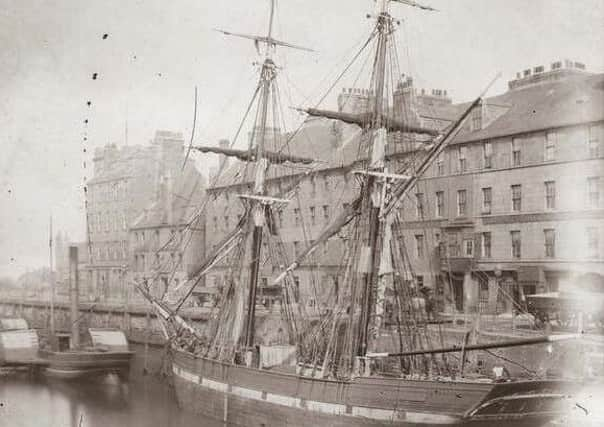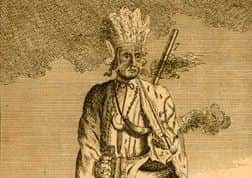Aberdeenshire boy sold to slavery and captured by Indians
This article contains affiliate links. We may earn a small commission on items purchased through this article, but that does not affect our editorial judgement.


Born in 1730, Peter Williamson was the son of an Aboyne crofter. His parents were ‘reputable, though not rich’ and they sent him, as a young boy, to live with an aunt in Aberdeen. At this time, kidnapping was a flourishing business in Aberdeen. Children were regularly kidnapped for sale in American plantations and a number of the Aberdeen City Bailies, who were in partnership with the kidnappers, amassed fortunes from this ‘hideous traffic in human merchandise’.
Kidnapped
At the age of 8, Peter was on the harbour at Aberdeen when he was spotted by two men employed by an unscrupulous and wealthy Aberdeen merchant. Peter was forcibly snatched and locked up with 68 other boys below deck on a boat. After an 11-week voyage across the Atlantic, the ship was wrecked on a sandbank off southern New Jersey.


Advertisement
Hide AdAdvertisement
Hide AdPeter was then sold as a slave in Philadelphia for the ‘handsome sum’ of £16. He was indentured for a period of seven years to a fairly well off planter, Hugh Wilson, who had himself been kidnapped as a boy.
Just as Peter’s period of indenture was about to end, Wilson died and bequeathed Peter ‘£120, his best horse, saddle and all his wearing apparel’.
At 24, Peter married the daughter of a wealthy planter. His father-in-law provided a dowry of 200 acres of land on the frontiers of Pennsylvania, and Peter settled down to his new life.
However, marauding Indians began to prove troublesome, instigated by the French who paid £15 for every British scalp taken. On the night of October 2nd 1754, Peter was in his house alone when Cherokee Indians surrounded it. He was captured, and his house was plundered and burned. He was force marched many miles, witnessing along the way the murder and scalping of numerous settlers. Peter somehow managed to survive, and made a daring escape from his captors. His brush with the native Indians would later earn him the nickname ‘Indian Peter’.


Advertisement
Hide AdAdvertisement
Hide AdShortly after, he enlisted in one of the army regiments established to combat the French and Indians in the colonial war. For three years he served as a soldier, rising to the rank of lieutenant and was present at the Battle of Oswego, in 1756, where the British forces were compelled to surrender and he was taken a prisoner of war by the French.
After being marched to Quebec, Peter embarked as an exchange prisoner on a ship bound for Plymouth, where he arrived in November 1756.
Return to Britain
He arrived penniless in York, where he was fortunate enough to interest ‘certain honourable and influential men’ in his case. They assisted him in the publication of an account of his unusual adventures and experiences. The book was given the long-winded title: “French and Indian Cruelty, exemplified in the Life and various Vicissitudes of Fortune of Peter Williamson, who was carried off from Aberdeen in his Infancy, and sold as a slave in Pennsylvania.”
It gave remarkably good value for money, made excellent reading and created quite a stir in York. A thousand copies were sold and Peter made a net profit of £30 with which to continue his journey to Scotland.
Advertisement
Hide AdAdvertisement
Hide AdOn his travels northwards, he made some additional money by selling copies of his book and giving displays of Indian life: ‘Armed to the teeth and painted like a Red Indian, he would enter a town, whooping and screeching until he had attracted a sufficiently large crowd. Then he would windmill his arms madly and give his impression of a war-dance.’ At the end of the show, he would take up a collection and sell copies of his book.
In June 1758, Peter finally arrived in Aberdeen, where his exhibition of American Indian culture attracted great crowds and his book sold well. The details of his kidnapping horrified the Aberdeen public. The merchants and magistrates of Aberdeen also took note of the book, particularly the part that accused them of being involved in the kidnapping business, and Peter was charged with offering for sale a ‘scurrilous and infamous libel upon the merchants and magistrates of the town’.
Copies of the book were seized and burned at the market-cross by the common-hangman. Peter was imprisoned until he signed a declaration that the account of his kidnapping was false, he was then fined ten shillings and banished from Aberdeen as a vagrant.
Edinburgh coffee house
Peter made his way to Edinburgh, and found the city and its people much to his liking. The large hall in which the Scottish Parliament had met was then a meeting place associated with the adjoining law courts, and here Peter established a coffee-house that became a favourite meeting place of lawyers and their clients. The coffee-house consisted of ‘three or four very small apartments, one within another; the partitions made of the thinnest materials; some of them even of brown paper’.
Advertisement
Hide AdAdvertisement
Hide AdRobert Fergusson’s poem, the Rising of the Session, described the lawyers departing for their summer break and devotes a verse to Peter’s coffee-house:
This vacance is a heavy doom
On Indian Peter’s coffee-room,
For a’ his china pigs (bottles) are toom (empty)
Nor do we see
In wine the sucker bisket (sugar biscuit) soom (swim)
As light’s a flee.
Peter sold copies of his book in the coffee-house and was encouraged by his lawyer customers to raise an action against the magistrates of Aberdeen. The case was heard in the Court of Session and the verdict was unanimous in Peter’s favour. The Provost of Aberdeen, four Bailies and the Dean of Guild were ordered to pay a fine of £100 sterling, as compensation to Peter. His kidnapping was the best documented and, at the time, the most celebrated case of kidnapping.
During these legal actions, Peter had also been busy in other areas. He had a lively and ingenious mind, and ‘aided by the knowledge he had acquired in scenes more bustling than the Scottish Capital, he became a projector of schemes, locally new and unheard of, some of course visionary, but others practicable and likely to be generally useful’.
He became proprietor of a famous tavern in Edinburgh’s Old Parliament Close and, as a result of his earlier adventures, the sign over the tavern read: PETER WILLIAMSON, VINTNER FROM THE OTHER WORLD.
Advertisement
Hide AdAdvertisement
Hide AdPeter is described as being a ‘robust, stout, athletic man and a great wag, of very jocular manners’ and was a popular landlord. His occasional exhibitions, when he dressed as a Delaware Indian were also an attraction of considerable interest. A wooden figure of him in Indian dress stood as a signpost outside the tavern. The Edinburgh magistrates assembled at Peter’s tavern for the ‘deid chack’, the dinner they took after attending a hanging.
In 1773, Peter compiled Edinburgh’s first street directory - a product of his new business venture, a printing-house in the Luckenbooths. Several years earlier, he had brought a new portable printing press from London and taught himself the craft of printing. He also invented a portable printing press which was able to print two folio pages, ‘with the greatest expedition and exactness’, and he would travel with his press to country fairs giving ‘exhibitions of the wonder of printing to the astonished rustics’. At the same time, he developed stamps and ink for marking linen and books ‘which stands washing, boiling and bleaching, and is more regular and beautiful than any needlework.’ Another of his inventions was an early example of a basket scythe which he described as ‘being able to do more execution in a field of oats do in one day, and to better purpose, than it is the power of six shearers’.
In 1776, he launched a weekly periodical, The Scots Spy or Critical Observer, which ran for a total of ten months. It was published every Friday and consisted of a mixture of local gossip and articles.
During the time that Peter ran the coffee-house, he was frequently asked to arrange the delivery of letters and he employed a man to deliver them for a small charge. This gave Peter the idea for one of his most successful ventures – a regular postal service throughout the city.
Advertisement
Hide AdAdvertisement
Hide AdThe earliest information about this is an advertisement in the second edition of his Edinburgh Directory published in 1774: ‘The Publisher takes this opportunity to acquaint the Public that he will always make it his study to dispatch all letters and parcels, not exceeding three pounds in weight, to any place within an English mile to the east, south and west of the cross of Edinburgh, and as far as South and North Leith, every hour through the day for one penny each letter and bundle.’
The main office for Peter’s postal service was in the Luckenbooths and he appointed seventeen shopkeepers in different parts of the city as official receivers of letters. He employed four uniformed postmen, who wore on their hats the words Penny Post and were numbered 1, 4, 8 and 16, so that the business would seem much larger than it actually was. Peter’s Penny Post was the first in Britain and he ran it for thirty years. In 1793, the Williamson Penny Post was integrated into the General Post Office and he received a pension of £25 for the goodwill of the business.
In Robert Fergusson’s poem, Codicil to Robert Fergusson’s Last Will, he mentions Peter’s Penny Post:
To Williamson, and his resetters
Dispersing of the burial letters,
That they may pass with little cost
Fleet on the wings of penny-post.
Advertisement
Hide AdAdvertisement
Hide AdIn his latter days, Peter returned to his old business and kept a tavern at Gavinloch’s Land in Edinburgh’s Lawnmarket, where it is thought that he ultimately became addicted to alcohol.
He died on January 19th 1799, and was buried in an unmarked grave in the Old Calton Cemetery, about fifteen paces north-east of the Martyr’s Monument.
The Scot’s Magazine wrote:
‘At Edinburgh, Mr. Peter Williamson, well known for his various adventures through life. He was kidnapped when a boy at Aberdeen, and sent to America, for which he afterwards recovered damages. He passed a considerable time among the Cherokees, and on his return to Edinburgh amused the public with a description of their manners and customs, and his adventures among them, assuming the dress of one of their chiefs, imitating the war whoop, &c. He had the merit of first instituting a Penny-post in Edinburgh, for which, when it was assumed by Government, he received a pension. He also was the first who published a Directory, so essentially useful in a large city.’
If you enjoyed the above article you may want to read: Secret Edinburgh published by Amberley and written by Jack Gillon
